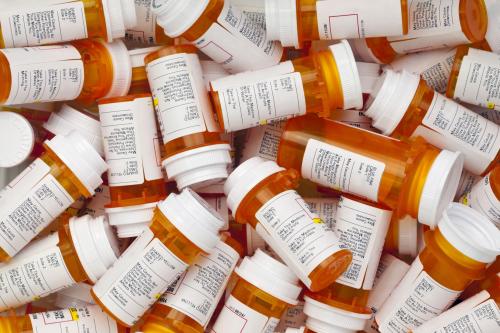This analysis is part of the USC-Brookings Schaeffer Initiative for Health Policy, which is a partnership between Economic Studies at Brookings and the University of Southern California Schaeffer Center for Health Policy & Economics. The Initiative aims to inform the national health care debate with rigorous, evidence-based analysis leading to practical recommendations using the collaborative strengths of USC and Brookings.
On November 27, 2020, the Trump administration published in the Federal Register an interim-final rule to use Medicare’s demonstration authority under the Center for Medicare and Medicaid Innovation (CMMI) to make large reductions in the amounts it pays physicians for high-cost medicines they administer under Part B. The goal is to lower payments to be more in line with prices in other advanced countries. This rule addresses a real problem—that prices for many Part B drugs are effectively constrained by neither market forces nor regulations—but deals with it in a flawed manner.
The policy reduces the amounts that Medicare pays physicians but not the prices that manufacturers charge physicians, putting physicians at risk of large financial losses if manufacturers do not lower their prices to reflect the sharply reduced Medicare reimbursement. While manufacturers of drugs used mostly by an elderly population might be compelled to reduce prices, this is not likely to be the case for drugs used extensively by people under age 65. Indeed, the Medicare Actuary (Table 11) estimates that 1 in 5 Medicare beneficiaries—such as cancer patients—would lose access to drugs subject to this regulation, with another 1 in 10 Medicare patients forced to shift where they get their care to access these drugs. In addition, implementation on such short notice would lead to administrative chaos for physicians, manufacturers and the carriers that administer Medicare Part B.
The interim final rule appears both procedurally flawed and inconsistent with CMMI authority, and legal challenges have prevented it from being implemented on January 1, 2021 as scheduled. The Biden administration can either defend the interim final rule or withdraw it. Withdrawal creates the option to issue a new proposed and final rule reforming payment for physician-administered drugs.
While we believe that the policy advanced in the interim final rule should not be allowed to go into effect, we also believe that reform is needed and have written this blog to sketch out a viable policy that could be pursued instead. We first explain the unique issues for drugs administered by physicians why the interim final rule would be highly disruptive, and then outline our proposed policy, which includes both competitive and regulatory elements.
Medicare Payment and Drug Distribution
In contrast to the distribution of self-administered drugs through pharmacies, physician-administered drugs are purchased by physicians, marked up, and sold to patients—a system referred to as “buy and bill.” Medicare bases payment for physician-administered medicines on the prices charged for products grouped together into a single billing code, plus 6 percent of the “average sales price” (ASP) for that billing code. (Medicare also separately pays physicians for the cost of administration based its physician fee schedule rather than the cost of the medicine.) Unlike retail pharmacists, physicians unilaterally control the choice of medicines they administer, which means economic incentives rather than solely clinical factors can influence prescribing decisions.
This system creates meaningful price competition among manufacturers only when multiple manufacturers’ products are placed in the same billing code. Indeed, physicians are actually paid more when they choose a drug in a billing code with a higher ASP and thus have incentives to prefer medicines in billing codes with higher ASPs.[1] In practice, most Part B spending on physician administered medicines is accounted for by billing codes that contain a single manufacturer’s product. This includes all single-source drugs and all innovator biologic products. Effective competition does exist in some instances, however. Notably, brand-name small-molecule drugs are placed in the same billing code as their generic alternatives. Biosimilars are placed in their own billing code, have their own ASP, but their add-on payment reflects 6 percent of the innovator’s ASP, which slightly mitigates physicians’ incentives to prefer the innovator drug over its biosimilar competitors.
The proposed policy would likely radically disrupt economic incentives for physicians. It and make what Medicare pays for some medicines systematically less than physicians’ acquisition and administrative cost, which would cause them to lose money when administering those drugs. Large financial losses would limit access for Medicare patients to medically needed medicines, as projected by the Medicare Actuary.
Under the current drug distribution system, distributors do not vary what they charge a supplier (whether a pharmacy or physician) for a manufacturer’s drug according to a patient’s type of insurance coverage. In fact, the current drug distribution system lacks the ability to track which payer is associated with a specific patient to whom a product is administered. Physicians purchase drugs without knowing which patients will need them and whether they have employer-based coverage or Medicare coverage. As a result, if manufacturers wanted to respond to the Medicare reimbursement reductions under the proposed policy by cutting prices of drugs going to Medicare beneficiaries but not those with employer-based coverage, substantial changes in the distribution system would be required. For example, Medicare could track claims and report utilization back to manufacturers to allow them to pay rebates to physicians to reduce net acquisition cost. But it would take substantial time for Medicare to set up such a system, something more suitable for a permanent policy change than a demonstration.
For drugs that are used mostly by an elderly population, such as injections for wet age-related macular degeneration, it is likely that manufacturers would reduce prices to allow physicians to avoid losing money. But for drugs that are used widely by younger populations, manufacturers would not be willing to do this due to the implications of getting less revenue from patients not covered by Medicare. And Medicaid “best price” rules would mean that a manufacturer’s price reduction to help physicians to avoid losses when administering drugs to Medicare payments would also reduce the amounts that can be charged to Medicaid agencies.
A Different Policy Approach
We believe that reform of payment for drugs administered by physicians needs to include both competitive and regulatory elements. This judgment reflects the fact that competition exists for multiple-source drugs included in the same billing code (such as a brand and generics) and can be enhanced for innovators with biosimilar competitors. For innovator medicines that have therapeutic alternatives (but not biosimilars), competition could also be enhanced. However, Part B single-source innovator medicines without either biosimilars or therapeutic alternatives lack the realistic prospect of competition, rendering strategies that rely on competition unlikely to effectively lower prices for these products.
Changes in Mark-ups. The Medicare statute directs paying physician practices 100 percent of ASP plus an additional 6 percent of ASP. The Obama administration tried to tweak the add-on payment by combining a lower percentage payment with a fixed dollar amount and the Bipartisan Policy Center proposed a flat add-on payment for medicines grouped by diagnosis and therapeutic class. The Obama proposal was derailed in part by the opposition of physician advocates, who contended that selling prices vary by practice, presumably with larger practices getting lower prices, so the lower percentage might have led to some practices losing money for the more expensive drugs. Recently, some private insurers have avoided this problem by paying physicians substantially more to administer a lower cost alternative and not changing what is paid for the more expensive drug. In treatments for macular degeneration, where the difference in price between Avastin, on the one hand, and Lucentis or Eylea on the other hand, is more than 20-fold, substantial rewards are paid by some commercial plans for administering Avastin.
Where effective competition occurs or can be enhanced, payment policy should give physicians greater incentive to choose, where clinically appropriate, the lower cost option. Rewarding this behavior would not only save money directly but also lead to manufacturers responding by lowering prices for the more expensive medicines in the class. Since costs of production for innovator medicines are only a small fraction of the price, such competitive forces can have a powerful influence on price.
Biosimilars. In conjunction with aligning economic incentives for physicians to enhance robust competition, a straightforward change would be to include both the innovator and the biosimilar in the same billing code. Medicare would pay the same reimbursement based on the weighted average sales of all innovator and biosimilar products in the code. This would change the physician incentive substantially, while also lowering beneficiary co-insurance. It is not surprising that in the U.S. many approved biosimilars have not yet been marketed—physicians have no incentive to use the biosimilars if they earn more by administering the innovator medicine. (A separate factor that might partially explain why biosimilars in the US lag those in Europe might involve the prevalence of aggressive patent challenges in the US).
Going beyond grouping together each innovator and its biosimilar competitors, Medicare could establish single codes covering therapeutic alternatives—differing medicines that can be used to treat the same condition—paying the same amount for differing but therapeutically related medicines. This would align Part B more closely with the formularies adopted by Medicare Part D plans and commercial insurers. Alternatively, Medicare could retain separate codes for therapeutic alternatives but blend reimbursement to provide less stark incentives to use less expensive alternative medicines.
Changes in “Buy and Bill.” Other reforms propose more substantial changes in the buy and bill system for physicians, such as not having physicians take ownership of drugs—they would be paid an amount for storage and administering the drug. Their patients would then benefit from the physician using the lower-priced drugs and the physician earnings would not be impacted by which alternative they administer. Or vendors could be created to act on behalf of physicians to negotiate prices with manufacturers, seeking discounts in return for steering volume to the drug being discounted. Vendors, which could include large medical practices, would have to influence affiliated physicians to shift utilization toward the lower cost drugs. This would be analogous to the role that PBMs play with pharmacy-dispensed drugs.
Regulation. Nevertheless, with an important share of Part B drug spending for medicines without the prospect for effective competition, engaging market forces and competition cannot address a large part of the problem; regulation would be required. Given the distribution system for physician-administered drugs and concerns about maintaining patient access, regulation would need to apply to manufacturer prices rather than what Medicare pays. Extending regulated prices beyond Medicare Part B would reduce health spending on medicines (but concomitantly lower manufacturer revenues). When private insurers pay too much for drugs, that drives up premiums, burdening employers and employees that purchase coverage and government, which subsidize both employer-based coverage (through the tax system) and subsidizes individual coverage directly. However, fewer drugs might be developed if potential returns are reduced.
Policy makers in the U.S. have been considering pegging U.S. prices to prices in other advanced countries. This approach has been adopted by the Trump administration and in legislation passed by the House in the last Congress (H.R. 3). Linking to international prices has the attraction of being able to be scored easily by the Congressional Budget Office, but is vulnerable to various types of gaming and other problems and it would lead to strong incentives for manufacturers to raise reported prices abroad. It might be useful as a transitional step to rely on prices determined in other countries, but longer term it would be better to create a U.S. based system in which an entity either in the federal government or that is funded by government gathers information on the effectiveness of drugs and uses estimates of value to set a price limit. This is similar to the process in use by many of those advanced countries that have lower drug prices. Indeed, President Biden pointed to Germany during his campaign. Rather than “outsourcing” critical regulatory decisions to these countries, it would be better to create our own system that reflects American values concerning how much is appropriate to pay to improve health outcomes.
[1] For the minority of patients without supplemental coverage, physicians might take into consideration the 20 percent coinsurance that patients pay.





Commentary
Medicare payment for physician-administered (Part B) drugs: The interim final rule and a better way forward
February 10, 2021